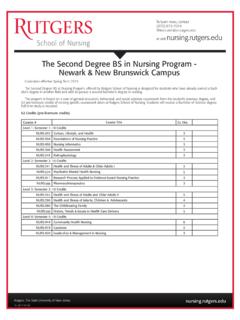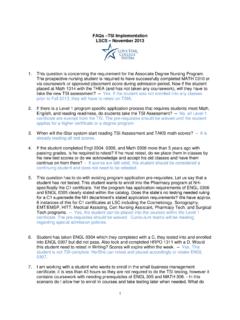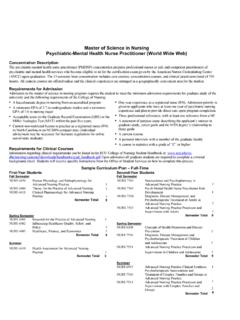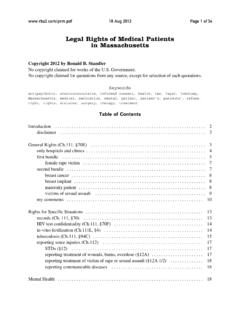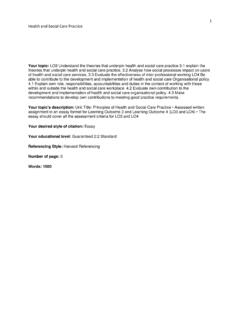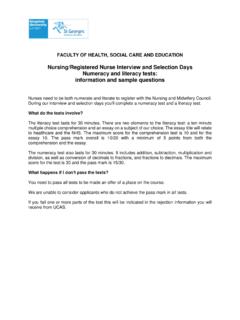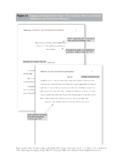Transcription of Family Systems & Murray Bowen Theory - houd.info
1 Family Systems & Murray Bowen Theoryby Carl V. Rabstejnek, , , SummaryMurray Bowen Family System Theory is one of several Family models developed by mental healthpioneers in the decade or so following the Second World War. For a short postwar period of time,drug therapy was not yet effective and parents were still implicated in their child s treatment began to take hold after the introduction of Thorazine to the ,in 1957. In 1983, E. Fuller Torrey published the first edition of his book, Surviving Schizophrenia:A Manual for Families, Patients, and Providers, which absolved parents and condemned spite of its roots in schizophrenia research, elements of Murray Bowen s Theory have beenincluded by corporate, church, community, and coaching programs for their organizational personneltraining. His work survives because he provided a comprehensive Theory that explained manypeople s behavior and emotionality in groups.
2 Bowenian ideas have been found useful forunderstanding volunteer, religious, and business organizations and the people who work for , these parapsychological coverages often tend to truncate the richness of his those wanting more elaboration, this paper will briefly describe the short but volatilehistory of the Family therapy movement and how it developed from the work of a few pioneers inthe late 1940's to a major influence today. Specifically, the extensive work of Murray Bowen willbe quickly traced and the Bowen Family Systems Theory will be described. This essay concentrateson the dynamics of the Theory and not its associated therapy. For those wanting more, good sourcesof detailed credible information are discussed and recommendations for further study are made. Family Therapy MovementTherapists began to explore the dynamics of Family life after World War II.
3 They observed thatmany battle-torn veterans readjusted after returning to their families. On the other end of the mentalhealth spectrum, researchers felt that they needed an explanation of why seriously ill patients did notrespond to, or regressed, after individual treatment, when they returned to their home to the Family therapy movement, psychiatrists and psychoanalysts focused on the patient salready developed psyche and downplayed current outside detractors. Intrinsic factors were addressedand extrinsic reactions were considered as emanating from forces within the person. Family therapists expanded the beneficial and toxic influences on the patient to include relativeswith whom the patient interacted. The relationship with others, not just intrapsychic forces, wasconsidered the primary basis for emotional states.
4 The importance of an individual s constitution wasde-emphasized by Family therapists. Thus, Family therapy was a new and different approach to understanding psychopathology. Inexplaining patients, schools of psychology tend to be somewhat mutually exclusive and , cognitive, humanistic, psychodynamic, psychoanalytic and many other adjectives havebeen used to modify the noun psychology. They all focus on their own assumed causes and influencesof human behavior. Similarly, with Family therapies the Family became the primary focus and de-emphasizedindividual factors. The cause of the problem seen by the therapist was no longer the identifiedpatient but the dysfunctional Family system (Foley, 1984). Unfortunately different belief campsbecome polarized and exclude other beliefs. Bowen (1984, Ch. 4) used the analogy of John GodfreySaxe's poem (cir.)
5 1850) about the blind men and the elephant to describe practitioners limited views: Family Systems & Murray Bowen TheoryPage 2 of 10 The Blind Men and The was six men of IndostanTo learning much inclined,Who went to see the Elephant(Though all of them were blind),That each by observationMight satisfy his Third approached the animal,And happened to takeThe squirming trunk within his hands,Thus boldly up and spake: I see quoth he, the ElephantIs very like a snake! Sixth no sooner had begunAbout the beast to grope,Than sizing up the swinging tailThat fell within his scope,I see quoth he, the ElephantIs very like a rope! First approached the Elephant,And happened to fallAgainst his broard and sturdy side,And began to brawl; God bless me! But the ElephantIs very like a wall! Fourth reached out his eager hand,And felt upon the knee.
6 What this wondrous beast is likeIs mighty plain, quoth he; T is clearly enough the ElephantIs very like a tree! so these men of IndostanDisputed loud and long,Each in his own opinionExceeding stiff and strong,Though each was partly in the right,And all were in the wrong! Second feeling of the Tusk,Cried, Ho! What have we hereSo very round and smooth and sharp?To me it might be clearThis wonder of an ElephantIs very like a spear! Fifth who chanced to touch the ear,Said: E en the blindest manCan tell what this resembles most;Deny the fact who can,This marvel of an ElephantIs very like a fan! MORALSo oft in theologic wars,The disputants, I ween,Rail on in utter ignoranceOf what each other mean,And prate about and ElephantNot one of them has seen!As with the blind men of Indostan, psychological camps only "look at" one part of the elephant.
7 I am not going to fully explain every aspect of Murray Bowen s Theory in the limited spaceavailable here, nor contrast it with other models. Guidance is offered to those who want to pursuethis subject further. You may notice that the key references are somewhat dated. That is the natureof a subject where the fundamental work was done a half-century ago. As interest in Family therapy proliferated, its findings needed to be communicated andcategorized. Nathan W. Ackerman and Don D. Jackson, two directors of institutes that dominatedthe field in the late 1950's, founded the Family Process journal in 1962. This was the firstpublication to deal primarily with Family therapy. Two earlier journals dealt more with the traditionalfamily environment. Founded in the ensuing 25 years were twelve additional American journals,eight American publications and newsletters, three English language journals, thirteenforeign language journals, and numerous other foreign does not cover themultitude of related articles in non Family oriented journals (Siuzuki, 1987).
8 The information surgeand the need to compare approaches led to classification and Green (1985) devote Chapter 2 of their book to attempts made since 1962 toclassify Family therapies. Alan Guerman and David Knidsen (1981) organized their Handbook ofFamily Therapy according to a twelve-fold format. Their approaches are grouped into four majorschools of Family psychoanalytic and objects relations approaches; intergenerational approaches; Systems Theory approaches; and behavioral (1987) offered another more general classification scheme: Carl V. Systems & Murray Bowen TheoryPage 3 of 10(1)Psychodynamic paradigm; (2) Family system paradigm;(3)General Systems paradigm; (4)Cybernetic paradigm; and (5)Ecological Systems the field of Family therapy developed, classifications received much is not a comparative paper and the above lists are only included to illustrate the depth andbreath of the Family therapy movement that began after World War II.
9 Bowen stood out among thesepioneers and developed a Theory that not only informed psychotherapists but has been adopted bymany organizations outside the mental health field to explain how people perform in , twenty-one pioneers in Family therapy were ranked by practicing Family therapists asmost affecting their practices (Kolevzon & Green, 1985, p. 27). Five pioneers stand out: VirginiaSatir, Nathan Ackerman, Don Jackson, Jay Haley, and Murray Bowen . Of these five, Murray Bowenand Nathaniel Ackerman both have roots at the Menninger Clinic in the late 1940's and early 1950' were trained physicians and psychoanalysts and shifted to Family therapy, although theyfathered different schools. This paper will address Murray Bowen and not contrast differentapproaches. The literature is replete with descriptive and comparative material about Family therapy(Kolverson & Green, 1985; Wolman & Stricker, 1983; Guerman & Kniskern, 1981).
10 Murray BowenMurray Bowen began his early work with schizophrenics at the Menninger Clinic, from 1946 to1954. Bowen studied the dyad of the mother and her schizophrenic child while he had them bothliving in a research unit at the Menninger clinic. Bowen then moved to the National Institute ofMental Health (NIMH), where he resided from 1954 to 1959. At the NIMH Bowen extended hishypothesis to include the father-mother-child triad and, remarkably, he had the whole familyhospitalized. This triadic relationship is crucial to the Bowen Family Systems Theory , or, moresuccinctly, the Bowen Theory . In 1959, he moved, again, to Georgetown University, where heremained until his death on October 10, 1990, of lung cancer. Incidentally, Bowen is the only familytherapy still having a personal name associated with a 1978 Murray Bowen published his only book, Family Therapy in Clinical Practice, coalescinghis work of the prior 20 years, 1957 to 1977.
